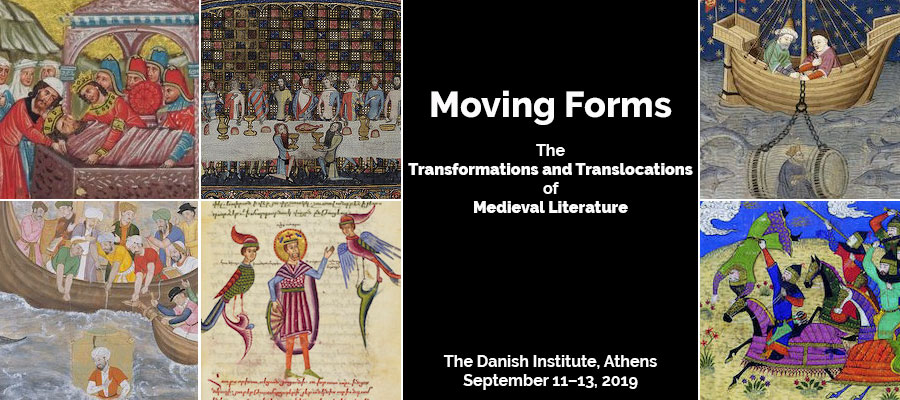Moving Forms: The Transformations and Translocations of Medieval Literature, The Danish Institute, Athens, September 11–13, 2019
The movement of people and books across space and time - mobility and portability – were driving forces of medieval European literary and intellectual culture. Men and women, clerical and secular, constructed extensive social networks and communities through travel, written communication, and the exchange of texts. Shared literary practices and forms occurred at the regional and transregional levels, defining local identities and forging links between people separated by distance and time. Around the North Sea and Baltic littorals, legends from the Norse sagas, for instance, were taken up by writers. On a larger scale, people from north-western Europe to China exchanged stories of Barlaam and Josephat, while tales of Alexander are found from India to Ireland; in both cases, transmission was facilitated by the movement of people along the Silk Road. Rather than a full picture, often we are left with a set of trails, traces and clues that challenge us to create narratives out of the fragments.
This symposium aims to contribute to the understanding of medieval literature through the development of methodologies which examine the intersection of social networks and communities with literary forms. We welcome papers that attend to the agency of people (men and women), genres (literary, scientific, philosophical, legal etc.), modes (verse, poetry, prose), styles, texts and manuscripts (book types, layouts, images) in creating literary links across space and time. Building on the practices of both comparative literature and entangled history, the symposium will open up connections between literary cultures often considered to be separate. At the same time, and of equal importance, it will be alert to the absence of connections, to discontinuities, exposing the diversities and ruptures of medieval literature, as well as the commonalities.
By following the movement of forms and tracing social connections from Antiquity to the Renaissance, we will interrogate both geographies and chronologies of medieval European literature. Always keeping the intersection of the social and the formal in view, the symposium will move back and forth between small and large scales of time and place: the local, the transregional, the European, and the Afro-Eurasian. Issues of morphology, scale and periodization will be central to discussion, enabling conversations across a wide range of material to gain traction. The symposium will bring together methodological and theoretical contributions, addressing the intersection of people and forms; we welcome papers that work on large scale typological models as well as papers that address broader issues though closely-worked case studies.
Questions to consider include:
- How do we move from specific examples to writing/formulating larger narratives, from the micro to the macro, from the close up to the panoramic, without falling into generalizations?
- What are the advantages and disadvantages of existing methodologies that account for the movement of objects, texts and people through space (e.g. histoire croisée, actor network theory, global history, etc.)?
- How does medieval Europe fit into a wider Afro-Eurasian space? How does Europe divide into and participate in regional geographies?
- How conscious were medieval people of new forms as a dimension of cultural exchange?
- What role does the modern historical imagination have to play in recreating social networks and formal encounters?
- How do medieval theories of cultural movement (e.g. translatio imperii et studii, spoliation, etc.) enable us to explain the transmission of literary forms?
